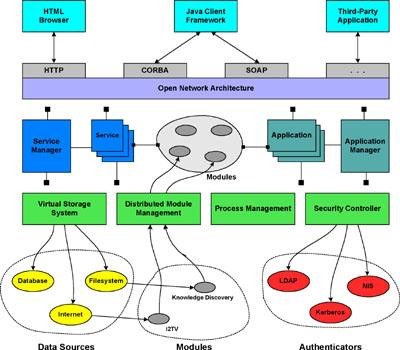
|
|
ERCIM News No.46, July 2001 [contents]
|
by Monika Fleischmann, Wolfgang Strauss, Jasminko Novak and Stefan Paal
The German Federal Ministry for Education and Research regards the promotion of competence centres dealing with artistic approaches and media culture as an important boost to the development of information technology. GMD’s MARS Exploratory Media Lab is developing a model for an online media laboratory as a competence centre for digital art, culture and technology.
GMD.IMK-MARS is developing an online media laboratory for interdisciplinary networking between digital art, culture and technology. As two fundamental pillars of an online media lab we consider the tools for active production and an architecture for connecting archives into a collaborative knowledge space. To this end the netzspannung.org system is conceived as a toolbox for experimentation with networked media spaces combined with structures for knowledge discovery. Such architecture is intended to serve both as a toolbox for active producers of digital culture as well as a public information interface. This requires an open and user-extendable architecture that enables the users (artists, designers, technologists) to explore, re-shape and re-design the platform to their own needs. To address these requirements we are developing a distributed community context architecture accompanied by a selected set of dynamic interfaces.
 |
| Figure 1: netzspanung.org distributed system architecture |
Open Platform Architecture
The basis is an open distributed system architecture. The challenge is to build a system which not only deals with different user requirements in the heterogeneous environment of the Internet, but also enables the users to modify and extend the system with new functionalities, data archives and interfaces, at different levels of expertise. Besides the ability to modify the platform itself, the users can integrate their own computers as active nodes in a distributed network of experimental media spaces. This is supported by the following system architecture:
Perceptive Interfaces
Our starting point is the design of interfaces for connecting the building blocks of real and virtual spaces to new modalities of perception. The basic set includes the timeline, netzkollektor, workspace, knowledge map and i2tv. The timeline is a multilayered, hypermedia structure that shows the development and mutual interaction of different works and discourses from art, science and technology in the form of contextualised information and a network of relationships. i2tv (interactive Internet television) is a mixed reality communication interface for live media productions and networked scenarios. It combines 3D Internet environments with digital television and mobile communication interfaces.
Knowledge Discovery
Methods for accessing, structuring and visualising existing information flows and databases on the basis of semantic relationships and self-organising maps enable the extension of isolated archives to connected knowledge spaces.
Distributed Module Management
Transparent integration of additional functionalities is enabled by dynamic location and loading of modules, and resolving of their dependencies. Modules can be located anywhere on the Internet and accessed as transparently as if they were stored locally on the machine.
Virtual Storage System
An open storage interface and data abstraction layer enable transparent access to heterogeneous data sources, without regard for where and how the data is stored. Different applications can share the same data archives, even when they span different storage types such as object-oriented and relational databases, XML repositories or network connections.
Open Network Architecture
A protocol abstraction layer supports the implementation of networked systems not only in Client-Server-Architecture, but also in a domain-based architecture or within a P2P network. This enables concurrent use of different network protocols (eg CORBA, SOAP) as well as individual selection based on the needs of a given application.
Distributed Server Framework
Though netzspannung.org does not want to specify how the implementation of server or client nodes must be designed, it provides a ready-to-go framework for distributed server implementations. The framework is a basis for extension by custom modules and provides both runtime and developer support. The C++ release is accompanied with a Java version, that comes with Java Servlet, Java Server Pages (JSP) and Extended Server Pages (XSP) support.
Java Client Framework
A community platform, which requires only a native HTML browser, can be accessed by most Internet users, without installing additional software portions. However, for more dynamic interfaces, active clients are needed. For this purpose, we provide a Java Client Framework that is able to run in a browser window and needs only a Java Plugin for execution. Additional software packages can be loaded from the server and extend the client with the needed functionality.
Pilot Projects
An important part of the development of netzspannung.org are pilot projects. The production potential of the platform is demonstrated and evaluated in exemplary applications in co-operation with individual artists and cultural institutions. The projects are selected thematically and involve research into concepts for collaborative knowledge spaces and networked media spaces on the basis of artistic models and strategies.
 |
| Figure 2: i2tv interface for ‘Ottos Mops’ distributed play. |
Links:
http://netzspannung.org/
http://imk.gmd.de/mars
Please contact:
Jasminko Novak and Stefan Paal — GMD
Tel: +49 2241 14 2809
E-mail: info@netzspannung.org